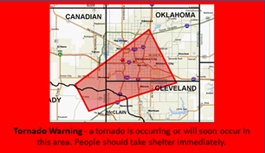
A storm system will continue to slowly move through the Gulf Coast and Southeast U.S. over the next couple of days, bringing a heavy rainfall threat through the weekend. Isolated instances of flooding may occur. On the north side of this storm system, colder air will support areas of mixed wintry precipitation and light snow from the Tennessee Valley to the Mid-Atlantic Friday. Read More >
South Carolina Severe Weather and Flood Safety Week is March 2-8, 2025
Statewide Tornado Drill rescheduled for Friday, March 7 at 9:00 AM


The South Carolina Emergency Management Division (SCEMD) and the National Weather Service jointly sponsor this week to remind people that severe storms, tornadoes and flash floods are significant hazards in South Carolina and people need to take proper safety precautions.
SCEMD and the National Weather Service are promoting awareness of the hazards associated with severe weather, including tornadoes and floods, and the procedures that help keep people safe.
A highlight of the week will be the annual statewide tornado drill. The drill is conducted in close coordination with the South Carolina Broadcasters Association. The State Superintendent of Education is encouraging schools statewide to participate. The National Weather Service will use the Routine Weekly Test (RWT) product on NOAA Weather Radio when the drill is conducted. The “RWT” code will activate tone-alert weather radios the same way the routine weekly test does every Wednesday, and those radios will broadcast the exercise message.
The drill will be conducted Friday, March 7, at 9 a.m. Public schools, state and local Emergency Management, the South Carolina Broadcasters Association, and others will participate in this annual event. The purpose of the drill is to test communication systems, safety procedures, mitigation processes, etc.
For further information on Severe Weather and Flood Safety Week, contact your county emergency management director, SCEMD or your nearest National Weather Service office. Additional resources can be found online at scemd.org/prepare and weather.gov/wrn/spring-safety.
Sunday: Types of Severe Weather
Monday: Watches and Warnings
Tuesday: Have Multiple Ways to Stay Connected
Wednesday: What to do during a tornado (and drill) or any extreme wind
Thursday: FLOODING! Stats and Danger
Friday: Turn around don’t drown, flooding home safety tips
Saturday: After the Storm (Storm damage reporting, recovery from storms and flooding, insurance, etc.)
Prepare for any Emergency:
TORNADOES
Although tornadoes are most common in the Central Plains and the southeastern United States, they have been reported in all 50 states. Most tornadoes in this region are relatively weak and short-lived, and mainly occur between March and May. However, tornadoes can occur at any time of day or night and at any time of the year.
Before a Tornado
During a Tornado
After a Tornado
Do you know what the difference is between a Tornado Watch and a Tornado Warning?
Click any one of the images below to find out more about the differences.
 |
 |
FLOODING
In South Carolina, several variations of flood hazards occur due to the different effects of severe
thunderstorms, hurricanes, seasonal rains and other weather-related conditions. The State's low-lying
topography, combined with its humid subtropical climate, makes it highly vulnerable to inland or riverine
flooding. Riverine flooding occurs when the flow of rainwater runoff is greater than the carrying capacities
of the natural drainage systems. The largest riverine flood in South Carolina, based on the area affected,
was the 1903 flood. Relentless rains associated with warm moist air and a low-pressure system caused
this flood. The textile communities of Clifton and Pacolet were hardest hit. The Pacolet River rose as
much as 40 feet in an hour, resulting in the deaths of sixty-five people.
In comparison to riverine flooding, coastal flooding is usually the result of a severe weather system such
as a tropical storm or hurricane, which contains an element of high winds. The damaging effects of coastal
floods are caused by a combination of storm surge, wind, rain, erosion and battering by debris. In 1999,
three tropical systems resulted in over 24 inches of rain in Horry County. The Waccamaw River and
tributaries caused significant flooding throughout northeastern South Carolina. More recently, significant
river and coastal flooding occurred with Hurricanes Matthew, Irma, Florence, Michael and Helene, as well as the
October floods of 2015.
Before a Flood
During a Flood
After a Flood
OTHER USEFUL LINKS